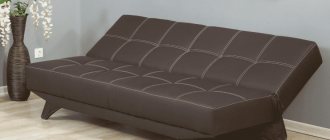Choosing a location for a home cinema
It’s better to think about your own mini-cinema at the planning stage.
Technical equipment - a TV or projector, sound, player - everything requires a network connection or communication between elements. It will be much more aesthetically pleasing if the wires are hidden in the wall or, at a minimum, neatly locked in a box.
It would also be a good idea to make at least partial sound insulation in the cinema area, lay sound-absorbing material in the walls, and carpet on the floor. If you choose a projector rather than a TV, you'll need to think about mounting a screen or painting a wall (more on that below).
As you already understand, all this requires knowing in advance exactly where the cinema will be in your apartment, and you can’t easily change this place later.
It is best if a separate room or niche is allocated for watching movies (which is more realistic in modern city apartments).
It’s even more realistic to turn your living room into a cinema. In this configuration, you can choose a transforming space and think through several lighting scenarios.
The ideal location for a cinema is 6 meters long and 4 meters wide. This is a standard that you can strive for if the square footage of your apartment allows it. But other sizes and shapes of the room can be arranged as a cinema hall. Just like in the bachelor’s apartment we wrote about earlier, a narrow living room is transformed into a cinema hall - the screen for the projector is simply lowered.
Other photos of the apartment can be seen here.
Private cinema hall: where to place it in the house?
If you live in a cottage, you can install the equipment on the ground floor or attic. If you have a country house or dacha, you can organize a place to watch movies together outside. An outdoor home theater has a special charm.
But installing equipment in these places is fraught with a number of pitfalls that can result in very unpleasant surprises for film fans:
| Base | Arranging a home theater in the basement of a building often requires real mathematical calculations that can be done by specialists. This is usually due to the height of the ceilings and the shape of the room, which directly affect the reverberation of the sound. Thoughtless installation of speaker systems can completely ruin the impression of the film. |
| Attic | The attic with its sloping ceilings also affects the reflection of sound waves. If there are observation windows on this floor, it is better to cover them with thick fabric. This way, daylight will not interfere with enjoying the film and will not disturb the cozy twilight of the cinema hall. |
| Open | An open-air cinema is a purely country option, because in urban conditions, watching films in the fresh air can simply disturb neighbors. Outside the city, when using a projector, there is also a risk of disturbing the peace of both neighbors and household members. |
How to Build a Home Theater: Part 1 (Steps 1-8)
In the early 2000s, having a home theater with a DVD player indicated either a high income or an exceptional passion for cinema. Today, home cinema has become as commonplace as installing washing machines or dishwashers in an apartment. There are a lot of offers, the prices are very affordable. In order not to get lost in this sea of proposals and plan correctly, the cultural center Hi-Fi.ru has released a step-by-step guide to creating a cinema at home. Welcome to the first part with descriptions of the necessary actions!
Decide on a room or part of it
The room is the most important part of the cinema. Of course, if you wish, you can organize it in the kitchen, but why? It would be best to use a separate room or living room/office. If this is not possible, allocate an area of 12 m2 of rectangular format in the room for organizing a recreation center. The ideal arrangement is along the long wall of the hall (this way the distance to the screen will be smaller, the effect of involvement will be greater, and room resonances will be minimized).
Advice:
If part of the room is used, it can be delimited by a screen or closet.
Decide if you need a projector
Here the buyer finds himself at the most important fork in two paths. Home cinema with a projector is the same “real” cinema, the opportunity to get complete immersion and a huge screen (limited, perhaps, only by the size of the wall of your room) for relatively affordable money. But the ergonomics are clearly “lame” - complete blackout will be required, you won’t be able to be distracted by a smartphone, and playing on such a system, again, will not be very convenient. The choice is yours. If the decision is up to the projector, there are now many models on the market to suit any budget: pay attention to the focal length and buy a screen of the appropriate size. And, yes, the ability to output signals in 4K HDR format, even with optical shift, is critical.
Advice:
DLP models, for example,
BenQ W2700 (RUB 128,000), provide 4K image output with optical shift of the Full HD matrix.
TV screen size is a major factor
When choosing a TV, banish doubts about its size. The rule here is simple - the more, the better (within the budget, of course). Even from one and a half meters, an 85″ TV will look great. Yes - there is no point in buying a TV with a real resolution lower than 4K (and with HDR). But the decision between OLED / LED is more complex. The former are more expensive, clearly better in black level and worse in brightness. The second ones are cheaper and more versatile. To save money - definitely LED.
Tip:
Samsung QLED TV 2020 line has the highest brightness and record black field depth for LCD technology.
Choose a component or soundbar system
If you use a soundbar, you can save a lot and not have to fuss with wires and arranging many speakers. But the quality of the sound will be slightly lower than that of a full-fledged component DC.
Advice:
The Sennheiser AMBEO Soundbar (5.1.4 format) can easily replace a full-fledged home cinema system - but the device costs RUB 179,900.
Decide what format and number of channels you will use
If you settled on a full-fledged home cinema with separated channels, decide how many of them you will use. The minimum scheme is 5.1, and then it all depends on your budget and requests - you can reach at least 14.4.
Advice:
Today's optimal surround sound system design for home installation is 7.2.1 - it guarantees the operation of the Dolby Atmos circuit with a pair of height channels.
Select receiver
The receiver is the heart of a “real” home theater, a device that is purchased for many years. Be sure to check that it has a sufficient number of inputs, support for all modern surround sound formats, options for working with 4K video, and enough power to pump all channels. To evaluate the latter, check the power consumption of the device and calculate the long-term power, making allowances for the system efficiency (class AB or D).
Advice:
AV receiver
Pioneer VSX-LX304 for RUB 74,990. works exactly in Dolby Atmos and DTS:X schemes up to 7.1.2 or up to 5.1.4.
... and a set of acoustics
We come to the most important thing - the speakers. The basic rule here is that the larger the size of the speakers and the internal volume of the speakers, the larger the sound will be. So, everything is limited only by finances, the size of the hall and its design.
Advice:
The Klipsch THX Ultra2 surround sound acoustics set is expensive (RUB 720,000), but a proven classic.
Don't forget the subwoofer
In total, up to four subwoofers can work in a home cinema room, but one will significantly improve the situation with the bass line. It is better to install it in the corner of the room, and the choice should be based on speaker criteria (dimensions, weight and size of the speaker, as well as the power of the built-in amplifier, if we are talking about an active model). And, yes, it is not at all necessary to choose a sub from the same manufacturer that made your speakers. Specialized companies have great competencies in this industry.
Advice:
REL T7i (RUB 84,990) is a gorgeous new sub from a highly specialized company.
Continued here
Denis Repin
January 1, 2020
Editorial staff of Hi-Fi.ru
Home theater design
Particular attention should be paid to furniture. Sofas or armchairs with decorative pillows on which you plan to watch a movie should not only fit into the interior, but also be as comfortable as possible.
An interesting interior solution is a floor with cascading platforms, like in a real cinema. This design will allow you to place furniture in several parallel rows. Thanks to this, the spectators sitting in front will not disturb those sitting on the sofa behind.
Carpet is the optimal solution for covering floors. The fabric has a beneficial effect on sound reverberation, and the variety of colors and textures of this material allows you to realize any design sophistication.
The project for the future design of the cinema hall should be based on the technical characteristics of the room. This is due to acoustics: in order for the sound quality to remain at the proper level, it is necessary to think in advance about the correct placement of the speakers, taking into account the shape and walls of the room.
Minimalistic interior with TV panel and projector
The authors of the project are Michael and Helen Miroshkin
The authors of the project are Michael and Helen Miroshkin
The living room in an open space with panoramic glazing (a project by Michael and Helen Miroshkin) includes a large TV area, which is equipped not only with a TV panel, but also with a film projector and a movie screen, which extends from an almost invisible structure under the ceiling. The favorite techniques of the project’s authors: minimalism, monochrome, luxurious finishing materials create the impression of an “interior of the future.” High technology in the film and TV zone fits perfectly into this style, both in meaning and form.
What style to choose for the room
A modern cinema, equipped right at home, looks most impressive in a style that is not burdened with a large number of details. Ideal for these purposes:
- minimalism;
- loft;
- high tech;
- lightweight variations of steam punk.
Fans of the classical movement should better abandon the idea of embodying this trend in a home cinema project.
When developing the concept of a room, it is also appropriate to provide an area for a bar and a mini-fridge. Alcoholic and non-alcoholic soft drinks, crispy snacks and delicious canapés will be indispensable when watching a movie with a small group of friends.
The presence of a children's corner in the cinema will greatly simplify the organization of leisure time for both children and their parents. A special sofa for the youngest viewers, decorated with large pillows in the shape of toys, will complement the stylish interior of the cinema hall.
Plus stereo
Very often, a home theater and stereo are combined in the same room, but the acoustic processing requirements for these two types of systems are significantly different. If for stereo it is necessary that the room is not very muffled and the listener can easily understand what space he is in, then in the case of a recreation center one must strive to almost completely get rid of room reflections. Imagine a dialogue scene in the desert, and you can clearly hear the room - the feeling of immersion will immediately disappear. What to do in such a situation?
Almost all processor-receivers have a music mode for working in stereo - reverberation will be added to the signal, which will go to the rear and surround speakers. This is the best solution for a recreation center combined with a stereo setup in one room, which is acoustically treated for a cinema.
Finally, another case of special acoustic treatment is the use of dipole speakers (rear or side). Since they use reflections from the walls, it is contraindicated to dampen the rear of the room; the main sound absorption is transferred to the front.
Continuation: Building a home theater: choosing acoustics, installing and configuring them (part 2)
Furniture
Comfortable furniture is the key to comfort and convenience for all spectators. To furnish this area, opt for wide sofas with long seats. This type of headset allows you to enjoy your favorite movies while reclining.
Due to the non-standard dimensions, it is better to order this piece of furniture from a furniture studio, whose specialists will not only design a durable wooden frame, but also select the ideal upholstery for the future sofa.
Soft single chairs with high armrests are suitable for those who do not tolerate violation of personal space. In front of such a chair you can place a low stool for your feet.
In front of the seats, it is advisable to place a table with low legs so that viewers of a cozy cinema can conveniently take drinks and snacks. The tabletop can be made of wood, glass or other materials. The appearance of the product depends solely on the style direction in which the cinema hall is decorated.
Treating the premises using the “home” method
When using materials and interior items as sound-absorbing and scattering materials, you need to remember several fundamental rules, following which you can achieve good results, although you will have to try.
- There should be as few smooth and hard surfaces as possible in the room (for example, walls covered with wallpaper).
- The room should have as many soft and textured surfaces and irregularly shaped objects as possible.
- No glass sideboards or shelves with dishes, also try to avoid suspended ceilings and plasterboard walls. If they are present or planned, the cavities between the ceiling/wall and the drywall should be filled with sound-absorbing material: Schumanet BM mineral wool or a similar filler with a dense fibrous structure. You should remember about sanitary standards (the material must be approved for use in residential premises, for this reason, try not to use glass wool or isover in the open) and fire safety (the material must be non-flammable).
- Excessive bass sounds cannot be attenuated or leveled out by lightweight, small-area absorbers due to the very nature of the propagation of low-frequency sound waves. Therefore, if you do not plan to build special bass traps on one of the walls or on the ceiling, install as many large poufs in the room as possible (especially in the corners), place large sofa cushions on the floor and in the corners, use a soft sofa, heavy (preferably double-layer) tapestry curtains in the largest and most frequent fold, place a carpet with dense and large pile on the floor. It also makes sense to hang rugs on the walls. The larger their area, the better (especially for small rooms). The effectiveness of wall hangings will increase significantly if they are attached only at the top edge to a wooden beam, so that they hang freely at a distance of 5-10 cm from the wall. In this case, they will act as an energy-absorbing damper for low-frequency waves. If the wall behind the listeners is free of furniture and other household items, you can arrange a homemade bass trap on it: purchase 2-3 heavy carpets (ideally the size of the wall) and hang them one in front of the other with an interval of 10-20 cm. Attach such carpets better to the ceiling. The cavities between the carpets can be hung with tapestry in a large fold. For beauty, you can hang a tapestry in front of the first carpet on the side of the room, hiding the entire structure from view. Do you think all this is crazy? Your right. We only offer a way: how to create a favorable acoustic environment using relatively inexpensive interior elements. Yes, most of the correction means will be visible in this case, but these are quite familiar things, and not specialized panels that turn the room into a technical room. It is important that such processing turns out to be the most profitable from a financial point of view.
Lighting in a movie room
Lighting fixtures in a home theater are not only decorative:
- Thanks to a properly designed lighting system, a person's eyes will not be strained as much while watching a movie.
- Spot lights help you move safely around the room during a home session.
The degree of illumination can affect the perception of the screen image, and directional light fluxes can even be reflected from the surface of the monitor, transforming into glare. Therefore, the most optimal solution for lighting a home theater is hidden lighting, the rays of which are directed at the wall or ceiling. Distribute lights evenly to avoid light spots.
Dimmable lamps are also suitable for recreating the cozy atmosphere of a cinema hall. Their soft, muted glow is ideal for background lighting in a room where all attention should be focused on the screen.
Cozy cinema for home viewing
Author of the project: Alexander Kravtsov
Author of the project: Alexander Kravtsov
And in this home cinema (the author of the project is architect Alexander Kravtsov), the cinema area is separated from the general space by a thin thread curtain - an elegant zoning option.
Choosing a color palette for your design
Traditionally, a room with a minimum number of windows is chosen for a home theater. Special roller blinds, blinds and heavy curtains will help darken the room. The wall on which the screen is installed is painted in a light color, and then surrounded by a dark outline or frame. The remaining walls, ceilings and floors should also be dark: brown, black, chocolate, olive, gray.











